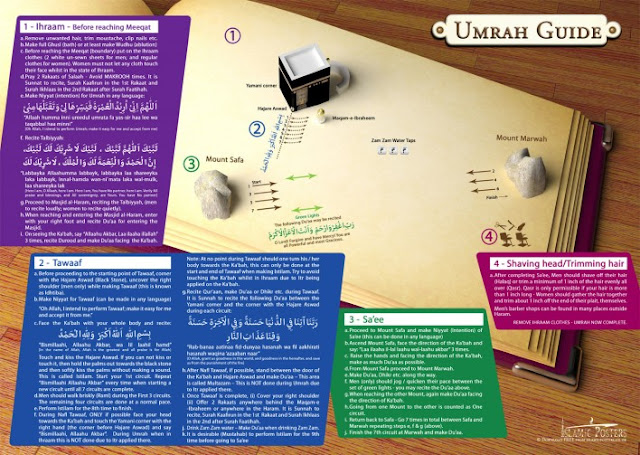Latest Post
1:33 AM
Umrah Hajj Guide
Written By Windi on Mar 21, 2013 | 1:33 AM
Just few months to go before we flew for the Umrah. The feeling that I
will be there was slowly sinking in, I must say I am very... very and super excited! I
have never felt so excited for any trip before. I cannot wait to be
there, to announce my attendance to my lord. To follow the footsteps of
Prophet Ibrahim (A) and Prophet Muhammad (S). I am eager to be a part of
it all.
Our travel group has arranged an Umrah step by step guide course. It was a full day course. I and my hubby
started doing our own research as well so that we can be prepared better
for the course and overall. I intend to post our findings here
Insyallah so that later it might benefit others as well.
So, as part of my search, I came across these two wonderful posters
from IslamicPosters.co.uk that gives a quick overview of Hajj and Umrah
and what needs to be done for each. |
| Umrah Guide from IslamicPosters.co.uk |
 |
| Hajj Guide from IslamicPosters.co.uk |
9:23 PM
The Umrah or (Arabic: عمرة)
The Hajj (Arabic: حج Ḥaǧǧ "pilgrimage", also spelled haj
What is Umrah and Hajj or Pilgrimage ?
Written By Windi on Mar 19, 2013 | 9:23 PM
What is Umrah and Hajj or Pilgrimage ?
The Umrah or (Arabic: عمرة)
The Umrah or (Arabic: عمرة) is a pilgrimage to Mecca, Saudi Arabia, performed by Muslims that can be undertaken at any time of the year. In Arabic, Umrah means "to visit a populated place". In the Sharia, Umrah means to perform Tawaf round the Kaaba and Sa'i between Al-Safa and Al-Marwah, after assuming Ihram (a sacred state), either from a Miqat like Zu 'l-Hulafa, Juhfa, Qarnu 'l-Manāzil, Yalamlam, Zāt-i-'Irq, Ibrahīm Mursīa, or a place in Hill. It is sometimes called the 'minor pilgrimage' or 'lesser pilgrimage', the Hajj
being the 'major' pilgrimage and which is compulsory for every
able-bodied Muslim who can afford it. The Umrah is not compulsory but
highly recommended.
(source : http://en.wikipedia.org/wiki/Umrah)The Hajj (Arabic: حج Ḥaǧǧ "pilgrimage", also spelled haj
The Hajj (Arabic: حج Ḥaǧǧ "pilgrimage", also spelled haj) is one of the largest annually occurring pilgrimages in the world,[1][2] and one of the five pillars of Islam, a religious duty that must be carried out by every able-bodied Muslim who can afford to do so at least once in his or her lifetime.[3] The Hajj is a demonstration of the solidarity of the Muslim people, and their submission to God (Allah in the Arabic language).[4]
The pilgrimage occurs from the 8th to 12th Dhu al-Hijjah, the 12th and last month of the Islamic calendar. Because the Islamic calendar is a lunar calendar, eleven days shorter than the Gregorian calendar used in the Western world, the Gregorian date of the Hajj changes from year to year. Ihram is the name given to the special spiritual state in which Muslims live while on the pilgrimage.
The Hajj is associated with the life of Islamic prophet Muhammad
from the 7th century, but the ritual of pilgrimage to Mecca is
considered by Muslims to stretch back thousands of years to the time of Abraham (Ibrahim).
Pilgrims join processions of hundreds of thousands of people, who
simultaneously converge on Mecca for the week of the Hajj, and perform a
series of rituals: Each person walks counter-clockwise seven times
around the Kaaba, the cube-shaped building which acts as the Muslim direction of prayer, runs back and forth between the hills of Al-Safa and Al-Marwah, drinks from the Zamzam Well, goes to the plains of Mount Arafat
to stand in vigil, and throws stones in a ritual. The pilgrims then
shave their heads, perform a ritual of animal sacrifice, and celebrate
the four day global festival of Eid al-Adha
Note :- ^ Hajj pilgrimage 2011: by numbers
- ^ Hajj 2012: Muslims Embark On Pilgrimage To Mecca
- ^ Berkley Center for Religion, Peace, and World Affairs - Islam See drop-down essay on "Islamic Practices"
- ^ Dalia Salah-El-Deen, Significance of Pilgrimage (Hajj)
- ^ a b Karen Armstrong (2000,2002). Islam: A Short History. pp. 10–12. ISBN 0-8129-6618-X.
- ^ a b c d e f Anisa Mehdi, John Bredar (writers) (2003). "Inside Makkah" (video documentary). National Geographic.
- ^ a b "BBC - Religion & Ethics - Eid el Adha". Retrieved December 2007, December 30, 2012.
Labels:
Hajj,
Pilgrimage,
Umrah






